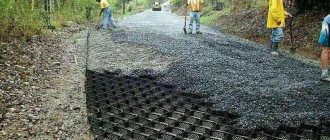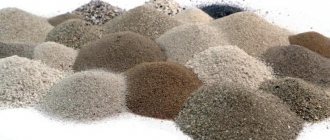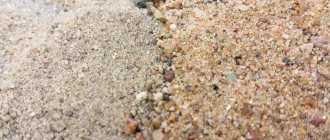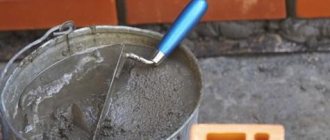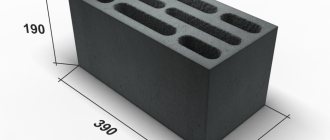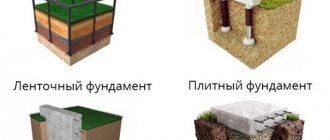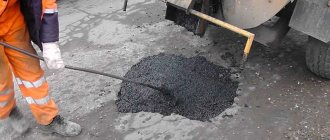Limestone crushed stone of different fractions. Photos of Soil Trucks
Enterprises provide a wide range of crushed stone . Material classification is carried out in accordance with several parameters . First of all, this is a type of feedstock; crushed stone is obtained by processing rocks, construction waste or slag from metallurgy. The second characteristic is the grain size, i.e. fraction.
This feature has a significant impact on the areas of application of the material, demand, and most importantly for the consumer - cost.
What is fractional crushed stone, definition, marking
Crushed stone is a bulk material with grains larger than 5 mm. , is one of the basic ones in construction. But the variety of types ensures the active use of the material in various fields of activity; with its help, a wide range of practical and decorative problems are solved. Crushing the feedstock using special equipment makes it possible to obtain grains of various sizes.
Fractions of marble crushed stone. Photo Petrovich
The fraction is a marking of crushed stone according to its size , the indicator is measured in millimeters, from the smallest to the largest, for example, 5-20, popular for making concrete.
GOST
In accordance with GOST 8267-93, crushed stone and gravel are produced in the form of main fractions:
- from 5(3) to 10 mm;
- St. 10 to 15;
- St. 10 to 20;
- St. 15 to 20;
- St. 20 to 40;
- St. 40 to 80(70);
- mixtures of fractions from 5(3) to 20.
Fractions of slag crushed stone. Dune Photos
There are also crushed stone and gravel in the form of mixtures of individual fractions, produced by agreement between the manufacturer and the consumer . However, manufacturers and suppliers often offer classifications of a different type ; the list of basic and non-standard fractions includes both a larger and a smaller number of types of material. This is due to the desire to provide consumers with the most complete range of crushed stone, as well as the demand for individual fractions . Therefore, on company websites you can find different divisions of crushed stone into standard and non-standard fractions. Some suppliers refer to crushed stone and crumbs with grains of 3-5 mm, which the state standard allows. But still, one should not confuse materials that differ in form and areas of use: screenings, crumbs, gravel and crushed stone.
Thus, it is possible to distinguish a significant number of crushed stone groups into fractions with their own individual sizes. But in most cases, a classification is used, according to which four groups of bulk material are distinguished:
- screening with particle size from 0 to 5 or 10 mm;
- fine crushed stone - from 5 to 20;
- average - from 20 to 40;
- large - from 40 to 70.
Mining and production
Obtaining grains of different sizes, i.e. fractions, becomes possible as a result of crushing and sorting of the feedstock. To produce crushed stone of primary types, obtained as a result of processing rocks of volcanic, sedimentary or metamorphic origin, the extraction of feedstock is required. To do this , the deposit is developed, the territory of the future quarry is cleaned and the rock mass is destroyed, which is carried out in several ways. There are main and associated mining sites.
Explosive mining method. Photos of Soil Trucks
In some cases, i.e. in the production of secondary types of crushed stone, the extraction of raw materials is not required, since it is used as waste slag from the metallurgical industry or broken bricks and concrete. As a result of processing these raw materials (crushing and sorting), manufacturers obtain separate fractions of slag and secondary crushed stone.
What kind of material is there, what is the difference between the fraction of different types of crushed stone: granite and not only
Consumers are provided with the widest choice of crushed stone in accordance with their origin, they differ in characteristics. But certain species are of increased interest:
- granite crushed stone fractions have excellent characteristics in terms of strength and frost resistance, which allows them to be used to solve particularly important tasks: road construction, arrangement of a cushion for the foundation, etc.;
- grains of gravel material are distinguished by minimal radioactivity and affordable cost, which ensures active use in work in residential areas;
Crushed gravel. Photos of Soil Trucks
- limestone is obtained by crushing sedimentary rocks, the material does not have outstanding characteristics, however, the properties may differ depending on the place of extraction, it has an attractive appearance, therefore it is used for landscape work, and is suitable for arranging drainage systems.
According to many experts, these types are the main ones, but others also require separate consideration:
- dolomite crushed stone is often confused with limestone, although the former has better strength properties;
- marble is valued by landscape designers; various fractions are used to create compositions, design flower beds and ponds, and build alpine slides;
- secondary and slag are obtained through waste processing, which ensures their low cost, and, accordingly, the demand for individual fractions for the implementation of not very critical projects;
- basalt has better (!even in comparison with granite) parameters of strength and frost resistance, therefore it is used to create a wide range of products for construction: soil, crushed stone, slabs, slabs, insulation materials;
- slate differs from its analogues in its flattened shape, which allows it to be used to form a covering for pedestrian paths and zoning landscape space;
Slate crushed stone. Photos of Soil Trucks
- foam glass - a material obtained by processing ordinary glass is not in high demand, but is of interest, which contributes to its distribution;
- agloporite and expanded clay - artificial materials obtained by firing clay and clayey rocks, soils, respectively, differ from other types in brown color.
Their application
The type and fraction determine the list of jobs for which the material is suitable. And the characteristics depend accordingly on the type and faction. Depending on the application, different parameters must be taken into account. For construction needs, first of all, attention is paid to strength, frost resistance, and flakiness. Doing the work yourself requires saving financial and labor costs. Let's consider where fractions of the three main types of crushed stone are used:
Granite crushed stone. Photo Petrovich
1) granite:
- fine granite crushed stone, in particular 5-20, is used for the manufacture of concrete for pouring foundations, floor screeds and fastening fence posts, for decluttering during road work, suitable for landscaping and for use in landscape design, although it is possible to select more affordable ones cost options;
- the middle fraction, the most popular 20-40, is used for drainage, arranging cushions for foundations and floor bases, for forming top layers during the construction and repair of dirt roads, suitable for decorating adjacent areas;
- Large granite material is used in the construction of buildings and roads with significant loads, as a filler for gabions and filling areas for various purposes, including parking lots and paths.
2) gravel has lower (in comparison with granite material) strength and frost resistance indicators, therefore it is used when performing similar work, but finished products and structures can withstand not such heavy loads :
- small grains are especially in demand in the construction industry, in particular the production of concrete and asphalt concrete, due to their low flakiness;
- mid-fraction material is used to construct cushions for foundations and roads;
- coarse fraction 40-70 is used in the construction of foundations and permanent foundations of structures, and can be used for drainage.
Limestone crushed stone 20-40 close-up. Photos of Soil Trucks
3) limestone:
- fine-grained material is suitable for preparing low-quality concrete mixtures, for pouring foundations of small and low-rise outbuildings, for backfilling dirt roads, flower beds, alpine slides, park and garden paths for pedestrians;
- the middle fraction is used for drainage, decluttering, arranging blind areas, backfilling primers and roadsides; its beautiful appearance and pleasant color make limestone an excellent option for decorative work;
- Large stone is actively used in road construction, landscape design and landscaping.
Weight of a cube of crushed stone of different sizes
The weight of crushed stone is influenced by several parameters : the type of raw materials used for the production of crushed stone, the coefficient of water absorption, the presence of impurities, storage conditions, as well as the shape and size of the grains. The weight and bulk density of crushed stone are indicators that are important when calculating the required amount of material, purchasing and checking the volume delivered by the company.
Fractions of marble and quartz. Photos of Soil Trucks
The weight of a cubic meter (5-20; 20-40 and 40-70) can be calculated using several formulas or taking ready-made tabular data . In both cases there are errors. Therefore, an accurate result can only be achieved by weighing the material.
Which crushed stone is better?
The construction of a high-traffic road from crushed stone involves choosing the hardest rocks that are resistant to mechanical stress and high pressure. For this purpose choose:
- Granite, frost-resistant type of crushed stone, resistant to moisture;
- Dolomite and limestone, used on roads with low loads and in inter-house driveways in holiday villages;
- Gravel, suitable for arranging a drainage layer;
- Basalt, the most durable type of crushed stone, suitable for the construction of bridge structures, foundations and load-bearing structures.
When choosing a fraction of a building material, it is important to take into account the likely loads on the road surface, the climatic conditions of the region, and the proximity of groundwater. The most preferred materials are medium and coarse fractions; the best option for asphalt is cube-shaped crushed stone with grains that are resistant to cracking. It is important to pay attention to the level of radioactivity of crushed stone, which must be acceptable for use in populated areas.
How to determine
Determination of the grain (granulometric) composition of crushed stone is determined in laboratory conditions. To do this, a sample of crushed stone of a certain mass is formed, which is dried and scattered on a set of sieves with holes of certain sizes. Perform these procedures yourself, i.e. at home, it won't work. Therefore, we will not dwell on this in detail. In addition, a separate publication is devoted to the composition of crushed stone and methods for determining it.
S-4 and other types of crushed stone-sand mixture
Crushed stone-sand mixture (alternative names: sand-crushed stone mixture, ShchPS, PShchS, crushed stone-sand) is a bulk construction material that contains sand and crushed stone in different proportions. It is believed that the proportions should be 50 to 50, but the content of materials in the mixture depends on several factors.
In accordance with the grain composition, several types of chipboard are distinguished, each of which is designed to perform specific work. In accordance with GOST, mixtures are divided into three groups:
1)For coatings:
- C1, fractions 0-40 , the percentage of large grains does not exceed 10%, is used for the construction of coatings that must have a perfectly flat surface, for example, for the construction of runways;
- C2, fractions 0-20 , is used for the construction of landing strips, roads of categories I-III, the finished coatings are resistant to water, temperature changes and mechanical loads.
PShchS granite. Photos of Soil Trucks
2) For bases (continuous granulometry):
- C3, sieving of large fractions 0-120 , installation of additional layers during the construction of road surfaces, the use of the mixture allows saving asphalt concrete;
- C4, fractions 0-80 , the content of large grains is no more than 10%, is considered one of the most popular materials, popular in the construction of highways, creating ballast cushions for tram and railway tracks, strengthening roadsides;
- C5, fractions 0-40 , is used in the construction of roads for various purposes, strengthening roadsides, and the construction of civil and industrial buildings;
- C6, fractions 0-20 , is used in residential, industrial and road construction, especially actively used for forming cushions for road surfaces;
- C7, fractions 0-10 and C8, fractions 0-5 , fine mixtures are used for the construction of cushions (lower layers) of road surfaces.
3) For bases (discontinuous granulometry):
- C9, fractions 0-80 , is used for the construction of roads and parking lots, strengthening roadsides;
- C10, fractions 0-40 , popular at the initial stage of highway construction;
- C11, fractions 0-20 , the main area of application is road construction.
Cuboid crushed stone
Cuboid-shaped grains indicate that the material has many useful qualities. Cuboid crushed stone is much stronger and more durable. Using cube-shaped crushed stone for the base of the roadway, road services increase the service life of the asphalt concrete pavement due to maximum density. This is a durable material that practically does not form cracks.
In addition, road work using cube-shaped crushed stone is low-cost; the overall savings are due to reduced costs for binding materials. The process of laying the asphalt concrete mixture is also simplified.
Where can I buy
Many companies sell crushed stone and sand-crushed stone mixtures; some manufacturers and suppliers are represented here.
Crushed stone fractions · 03/15/2021 · 0
